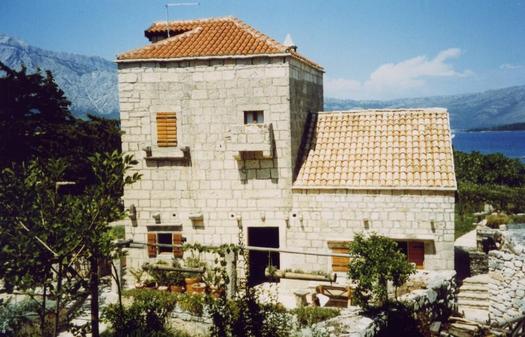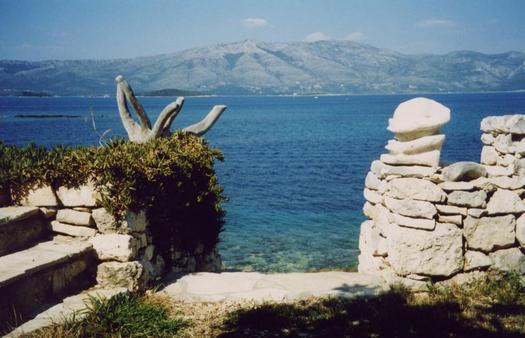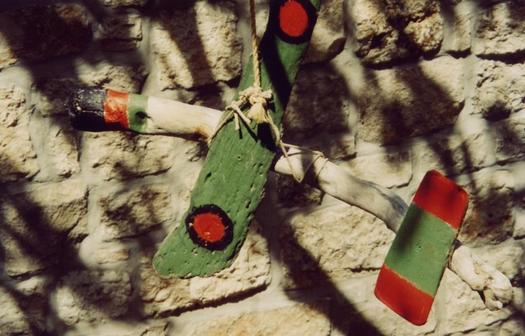
Rear view of Vladimir Beck's house on Vrnik, Croatia, 2005
I have just spent a couple of weeks on a small island called Vrnik, close to Korcula, which is part of the spectacular chain of hundreds of islands off the coast of Croatia. International memories of the savage war that tore Yugoslavia apart in the 1990s subside slowly and, although this area was always regarded as a good holiday destination, it has only been rediscovered in the last few years by a new generation of foreign tourists. In other words, it's wonderfully unspoilt, though the insoluble dilemma of modern tourism is that by pursuing the unspoilt with such collective determination, we inevitably spoil it in the end.
This was our third holiday in Croatia. We picked a house out of a brochure. The pictures looked promising, but the bland promotional text gave little sense of the remarkable property that awaited us. The house is owned by an artist, Vladimir Beck, a vigorous Croatian in his early 60s who moved to Stockholm and built a successful career as a painter, working in a manner that embraces surreal fantasy, Pop Art, folk scenes, and gentle erotica. Vrnik is known for its quarries, which date back to Roman times. Blocks of the hard white stone were used to construct the Hagia Sofia in Istanbul and many buildings in Dubrovnik. The island has around 45 houses, though just three all-year inhabitants. There are two chapels, but no shops, restaurants, roads or amenities. Beck spends part of the year on Vrnik, as does a Croatian sculptor, Lujo Lozica. During the summer, people arrive to occupy their holiday homes and sun-seekers cross the bay in boats to while away the hours on the picturesque stony shore.
Beck had his eye on the site for years before acquiring it in 1999. The stone house, which has magnificent views of the sea, the mountainous mainland and other nearby islands, was a ruin. A sepia photograph of Vrnik taken from a boat in 1908 suggests it may have stood empty for most of the 20th century. Its four walls survived, but it lacked a roof. By the time Beck arrived to begin work, the site was overgrown with trees. A single-storey addition to the main building had largely collapsed. The construction may date back to the 15th century (no one knows for sure) and there are signs that it began life as a chapel — there is a stone receptacle just inside the doorway for holy water.
Rather than starting again, Beck opted to make a virtue of the house's surviving features and to reconstruct the three-storey building, a task that took him five years. The amount of care, passion and physical labour that has gone into the project is overwhelming. The house achieves a perfect balance of original features — heavy stone lintels, alcoves, shelves and apertures, as well as an antiquated privy — with vital modern additions. Three balconies give it the look of a small castle. It's not the sort of place you would ever see in Wallpaper, though The World of Interiors, with its enthusiasm for all things unusual, would probably love it.

Stone wall at the front of the garden
The garden is a delight. A massive, three-tiered, dry-stone wall, which Beck has rebuilt and extended, faces the sea and the house sits on top of this pile. There are several terraces on different levels with steps, tables, benches and outdoor lighting, and everywhere you turn in the large garden there is somewhere to sit, some new view to take in of the house, the grounds, or the scenery. Huge walls and towers of chipped rock left behind by an army of stone-cutters rise up among the cypress trees behind the house, where the abandoned quarries are, and walking among them is like entering a piece of monumental land art. In the garden, Beck has constructed open-air stone ovens for grilling fish and making bread, with Gaudí-like chimney caps, and a small stone cottage for extra guests, equipped with indoor and outdoor showers. One of the most irresistible features, in the front garden, is a bench built from sinuous driftwood and slabs of weathered oak, shaded by a canopy of palms, looking out across the shimmering, pale-blue skin of the sea. You feel like a king drinking your coffee up there in the early morning sunlight.
Even this doesn't do the house justice. The building is completely at one with its location. (See, for contrast, Lorraine Wild's "The Scourge of 'Tuscan'".) It is made from the raw material of the land and its decorative details derive from local stone-carving traditions. After studying the house from every angle, we still failed to notice an eroded, moon-shaped face, floating like an apparition, carved into one of the stones high up on the side — Beck pointed it out. It appears to be as old as the structure. Beck took this motif as his starting point for the heads of animals, birds, fish, mythological figures and sometimes outlandish-looking people that he and a sculptor friend from Zagreb carved into the projecting stones that support the floor beams and jut from the outside walls. The garden abounds with stone carvings, some part of the fabric, others left sitting on walls or tucked away in corners to be found as you wander. Beck has fashioned eccentric mobiles from sea-scoured driftwood, rope, stones and shells, which hang in the living room and from a tree in the garden.

Detail of a mobile by Beck in the garden
Spending two weeks in this gem of a house made me question, yet again, rigid distinctions between artist and designer. Here, it's impossible to separate the two. Beck has designed every feature with a high degree of thought for what might make a domicile located in such a setting pleasurable and practical to live in. Everything is placed where you need it to be. The hundreds of artistic adornments that give the house so much character show what is possible when we take a more integrated approach to design and art, instead of reducing art to design — as when a painting is chosen solely because its colour values happen to suit an interior designer's conception of a room. Part of the art's charm is that it feels like a natural outgrowth, a casual accretion, something to take pleasure from as you live in the place, as much a part of everyday experience as sitting in the garden reading a book or enjoying a glass of wine. It couldn't be further from the over-inflated, dealer-boosted view of art that confuses status-greed and money-love with debatable claims of "cultural significance".
The house may be Beck's masterpiece. It's a shame in a way that, having finished his idyllic retreat, he realised it would make financial sense to rent his home to tourists in the holiday season since he spends these months at another house he owns in Korcula. Our good fortune — though it's going to be well-nigh impossible to equal this next summer.
Photographs: Rick Poynor


Comments [6]
In my experience, few places provide as intense an experience as spending time in an artist's own house. This is true, perhaps even more so, for architects. Several years ago, I visited within a short time period the private homes of Charles Moore (in Austin), Paul Rudolph (Manhattan) and Luis Barragan (Mexico City.)
In each case, although the owner was dead, you could feel his presence in every detail. This went far more than simply a designer indulging his whims when acting as his own client. Instead, I sensed an obsessive intensity that, in the case of Barrigan verged on the pathological, and in the case of Rudolph, the neurotic. These visits were some of the most memorable design experiences I've ever had.
07.28.05
10:15
I agree with your observation regarding artist's/architect's homes. If you're ever in Wisconsin, take a drive out to Spring Green to tour Taliesen -- Frank Lloyd Wright's home.
In today's parlance, I suppose these would be called "designed experiences". In reality, the creative people who made these homes were just creating a highly personal surrounding for their life using the unique gifts they were given. The fact that they resonate with others is their gift to us.
07.28.05
01:03
07.28.05
08:19
This link has more info and photos on Hagia Sofia:
http://www.greatbuildings.com/buildings/Hagia_Sophia.html
07.29.05
08:03
07.29.05
09:11
Back to Michael's comment, I too have found that being in an artist's or designer's home can be a little like stepping into a well-shot film. Each view, looking into the living room from the kitchen or looking across the living room from a couch, is often beautifully composed in a way that feels balanced and puts one at ease. Their living space, a 3D canvas, has had the luxury of being endlessly tweaked. A piece slid ever so to the left creating a gorgeous negative space, and palettes that ignite a feeling, whether bold and energized, or subtle and serene. Then there is the flip side - the home of someone who has no sense of layout. Not to sound painfully type-a, but I have a difficult time feeling truly relaxed in an unbalanced space or one decorated with "couch art" because it feels awkward and artificial. This makes me ponder how far apart the sensibilities of the artist/designer and interior decorator are.
07.30.05
11:45